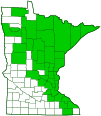white-spotted sawyer
(Monochamus scutellatus scutellatus)
Conservation • Description • Habitat • Ecology • Distribution • Taxonomy
|
|
|||||||||||||
Description |
White-spotted sawyer is a moderate-sized, shiny black, wood-boring, long-horned beetle. The adult female body is robust, broad-shouldered, ¾″ to 1 1 ⁄16″ long, and 3 ⁄16″ to ¼″ wide. There is a large, blunt projection on each side of the hardened covering of the thorax (pronotum). The hardened forewings (elytra) are shiny black, have a metallic appearance, and have small patches of white hairs. The small triangular plate between the bases of the elytra (scutellum) is covered with white hairs. The face is nearly flat. The antennae are black, are longer than the body, and project from a notch in the eyes. When they are held back along the body the last two or three segments extend beyond the elytra. Two segmented feeler-like structures (palpi) are attached to the lower jaw-like structures (maxillae). The last segment of each maxillary palp is pointed. The legs are reddish-black. The forward, middle, and back legs each have 5 end segments (tarsi). They appear as 4 segments because the minute fourth segment is concealed by the enlarged third segment. The male is similar to the female but smaller (not including the antennae). The elytra do not have patches of white hairs. |
Size |
¾″ to 1 1 ⁄16″ |
Similar Species |
Asian longhorned beetle (Anoplophora glabripennis) scutellum is black, not covered with white hairs. The white markings on the elytra of the female are much more conspicuous. The female has conspicuous white markings on the antennae. Northeastern pine sawyer (Monochamus notatus) scutellum is not white. |
Habitat |
Fire-damaged coniferous and mixed forests |
Ecology |
Season |
June to September |
Behavior |
|
Life Cycle |
Adults emerge in June or later depending on the weather. After mating, the female chooses a suitable location away from direct sunlight on the side or bottom of a dead or dying host tree or log. She then chews a slit into the bark and lays one or sometimes more eggs in the slit. Egg laying begins in early June and continues to early September. The egg hatches in 9 to 14 days. Within three days the larva tunnels into the cambium where it feeds until mid- or late summer. It then tunnels into the wood where it overwinters. In the spring it continues tunnelling, usually turning back toward the surface and creating a U-shaped tunnel. When it nears the surface it creates a pupal cell and plugs the end of the tunnel. It overwinters as a prepupa. In late May or June of the following spring the larva pupates. Two weeks later the adult emerges. In northern Minnesota this cycle requires two years. Farther south it may take only one year. |
Larva Food |
Dead or dying wood of conifers, especially eastern white pine, but also red pine, jack pine, balsam fir, white spruce, and black spruce, and occasionally tamarack. |
Adult Food |
Needles and the tender bark of twigs of conifers. |
Distribution |
||
|
Sources Biodiversity occurrence data published by: Minnesota Biodiversity Atlas (accessed through the Minnesota Biodiversity Atlas Portal, bellatlas.umn.edu, 6/12/2025). |
|
| 6/12/2025 | ||
Occurrence |
||
Common and widespread |
||
Taxonomy |
|
Order |
Coleoptera (Beetles) |
Suborder |
Polyphaga (Water, Rove, Scarab, Long-horned, Leaf, and Snout Beetles) |
Infraorder |
Cucujiformia |
Superfamily |
Chrysomeloidea (long-horned and allies) |
Family |
Cerambycidae (longhorn beetles) |
Subfamily |
Lamiinae (flat-faced longhorn beetles) |
Tribe |
Lamiini |
Genus |
Monochamus (sawyer beetles) |
Subgenus |
Monochamus |
Species |
Monochamus scutellatus (white-spotted sawyer) |
There are two subspecies on Monochamus scutellatus. Only the nominate subspecies, Monochamus scutellatus scutellatus, occurs east of the Rocky Mountains. |
|
Subordinate Taxa |
|
|
|
Synonyms |
|
Monochamus resutor |
|
Common Names |
|
spruce bug spruce sawyer whitespotted sawyer white-spotted sawyer white-spotted sawyer beetle |
|
Glossary
Cambium
A thin layer of soft growing tissue composed of unspecialized cells in the stems of plants. It provides new xylem to the inside and new phloem to the outside.
Elytra
The hardened or leathery forewings of beetles used to protect the fragile hindwings, which are used for flying. Singular: elytron.
Maxillae
Paired mouth structures of arthropods located immediately behind the mandible and used for tasting and manipulating food. “Under-jaws”.
Palp
Short for pedipalp. A segmented, finger-like process of an arthropod; one is attached to each maxilla and two are attached to the labium. They function as sense organs in spiders and insects, and as weapons in scorpions.
Pronotum
The exoskeletal plate on the upper side of the first segment of the thorax of an insect.
Scutellum
The exoskeletal plate covering the rearward (posterior) part of the middle segment of the thorax in some insects. In Coleoptera, Hemiptera, and Homoptera, the dorsal, often triangular plate behind the pronotum and between the bases of the front wings. In Diptera, the exoskeletal plate between the abdomen and the thorax.
Tarsus
The last two to five sections of an insect’s leg, attached to the tibia; the foot.
Visitor Photos |
||
Share your photo of this insect. |
||
This button not working for you? |
||
Luciearl |
||
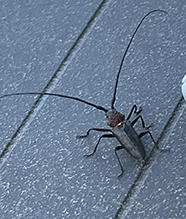 |
||
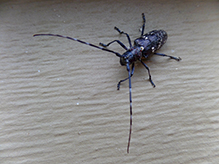 |
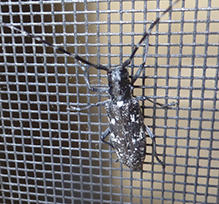 |
|
Found on my screen door. |
||
Alfredo Colon |
||
 |
||
 |
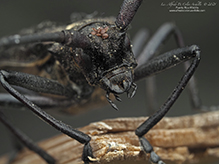 |
|
Mary Katherine May |
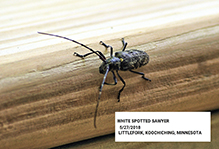 |
Bobbi Johnson |
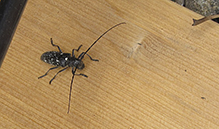 |
Christine A. Abell |
||
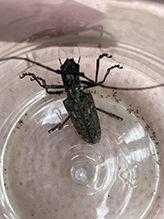 |
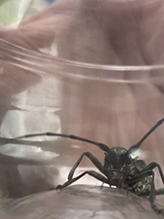 |
|
Jasmine |
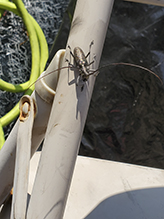 |
Rick Freitag |
 |
Bill Reynolds |
 |
They bite! |
MinnesotaSeasons.com Photos |
||
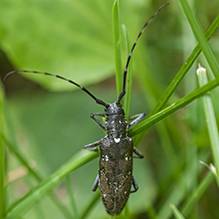 |
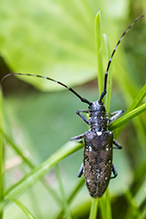 |
|
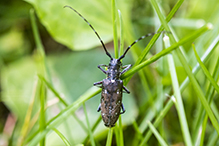 |

Slideshows |
Whitespotted Sawyer (Monochamus scutellatus) |
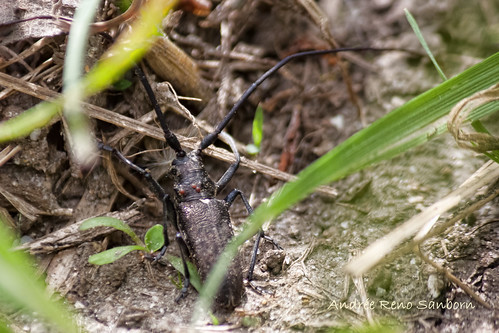
|
Monochamus scutellatus (White-spotted Sawyer) |
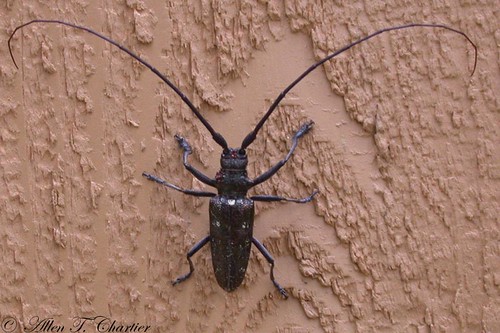
|

Visitor Videos |
||
Share your video of this insect. |
||
This button not working for you? |
||
Nathaniel Morris |
white spotted sawyer 01 |
About
whitespotted sawyer (Monochamus scutellatus scutellatus) |
Other Videos |
||
White-spotted Sawyer Beetle (Cerambycidae: Monochamus scutellatus) on the Move! |
About
Uploaded on Jul 3, 2011 Photographed at Nisswa, Minnesota (01 July 2010). Thank you to 'v belov' (@Bugguide.net) for confirming the identity of this specimen! |
Monochamus scutellatus |
About
Published on Dec 7, 2013 White-spotted Sawyer - A member of the Cerambicydae Family of Long-horned Beetles. Seen on a picnic table at Lightning Lakes in Manning Park, BC. I was sitting there when this critter came in for a landing. |

Visitor Sightings |
||
Report a sighting of this insect. |
||
This button not working for you? |
||
Luciearl |
Location: Fairview Twp. |
 |
| Nathaniel Morris 7/25/2022 |
Location: Augusta County Virginia he likes to talk alot |
Kelly |
Location: Potassium St., Ramsey, MN |
Mary Katherine May |
Location: Littlefork, Koochiching County MN |
| Alfredo Colon 7/8/2021 |
Location: Woodbury, Minnesota |
| Christine A. Abell 8/7/2020 |
Location: Wrenshall, MN |
 |
| Judy Schink 6/30/2020 |
Location: Aurora, MN St. Louis County Are these really harmful to trees? This one flew into the house. We captured and released. However, with trees lining the streets and being next to a city park with many pine trees, we are wondering if we should have disposed it instead. |
|
| John Valo 6/30/2020 |
These beetles are found especially in forested areas that have been recently burned. The female lays eggs in dead or dying wood. The damage is a concern to the logging industry because the larvae tunnels damage the wood. This boring beetle is not a threat to healthy trees. |
|
| Luciearl 5/26/2020 |
Location: Cass County Found on my screen door. |
 |
HaawZ71 |
Location: Bemidji, Minnesota |
Amanda |
Location: Park Rapids, MN |
| Jasmine 6/16/2019 |
Location: Monticello, MN |
 |
| Luciearl 6/2/2018 |
Location: Cass County |
 |
| Rick Freitag 7/19/2015 |
Location: Duluth MN |
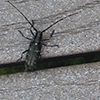 |
| Bill Reynolds 7/18/2003 |
Location: St Louis Co MN They bite! |
 |
MinnesotaSeasons.com Sightings |
||

Created: 2/2/2014 Last Updated: © MinnesotaSeasons.com. All rights reserved. |
